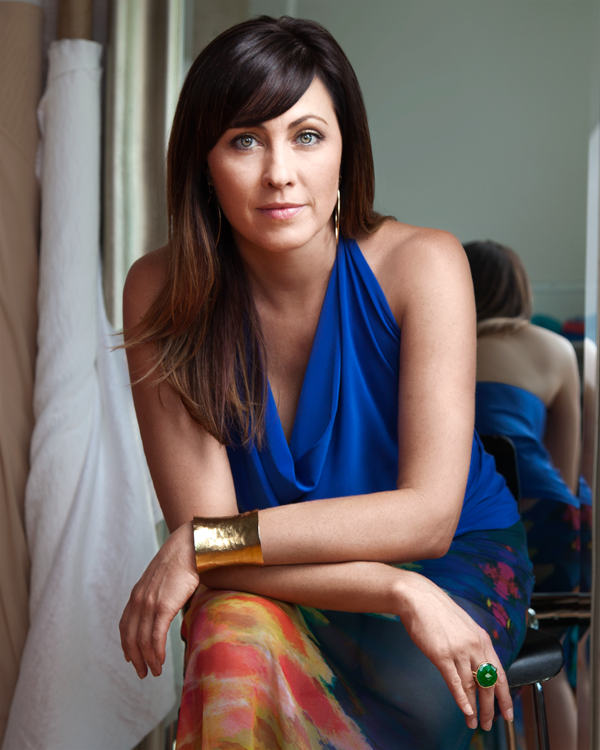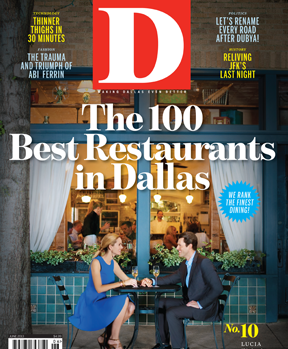“Abi, would this work off the shoulder?” “Abi, have you seen the second-quarter numbers?” “Abi …”
The ascending busyness and business of Dallas designer and dressmaker Abi Ferrin traces a perfect little arc: at age 13, she won the 11-to-14 age group in a national sewing competition sponsored by McCall’s magazine. At age 28, in 2007, she was named Texas’ Next Top Designer, an award that launched her career.
But in between point A and point B, and becoming a bright fashion light locally—and, increasingly, nationally—a lot of stuff could have easily derailed Abigail Ada Ferrin. She might have stayed back in the big country to run the family’s bed-and-breakfast, for example. Ferrin grew up under the wide Wyoming sky, with moose wandering through the front yard and the mountains always in the background—or under her skis or her horse’s hooves. She landed an amazing first job out of college, as an associate producer with PBS television mainstay The NewsHour With Jim Lehrer. She thrived in the high-pressure world of Washington journalism, plotting interviews and shots in the Rose Garden and prepping senators to pronounce on weighty matters. After three years in D.C., her breath fogging a glass ceiling, Ferrin moved to Los Angeles to produce network TV but noticed immediately that her conservative Ann Taylor wardrobe looked woefully out of place in the glamorous company she was keeping. Fortunately, her dormant sartorial art resurfaced: with pencils and scissors, swatches and a mannequin, she sat in a girlfriend’s tiny kitchen and made her own. Her creations got noticed, to put it mildly. “My God, who made that?” people asked. Dayna Devon, a host on the celebrity gossip TV show Extra, almost pulled Ferrin’s flowy dress off her back and put it on her own.
“I’d meet Dayna’s costume gal on the street, so she wouldn’t see that it was just me and a sewing machine on a kitchen table,” Ferrin says. Although movie and media stars don’t actually pay for their clothes, as Ferrin found out, they do provide exposure: “Miss Devon’s wardrobe by Abi Ferrin” in the credits. An (eventual) fashion empire was born.
And in L.A. she might easily have remained. It’s got a polyglot look Ferrin understands, and, after New York, it’s the second biggest center for the rag business in the country. With a magnetism that induces people to want to help and an unerring eye for what flatters the female form, Ferrin could have built a career draping red carpet walkers instead of fashion-forward Dallasites. Then, in a nightclub, she met a guy.
Perhaps “met” is not the right word. It was really more of a hijacking. Too bad: the guy turned out to be mere human debris. A charming sociopath, Ferrin’s new beau worked every angle, played every card. He seemed nice—beyond nice—when he came bearing just the right gift, the perfect compliment, and an invitation to a champagne picnic. But as the con man’s infatuation turned into obsession and control, the relationship spiraled down a dark hole. He held a gun to Ferrin’s head at one point, and it didn’t end there.
We think we know what we’d do in the aftermath of such a nightmare. “What all schoolchildren learn,” wrote W.H. Auden. “Those to whom evil is done/Do evil in return.” But neither the poet nor the perp could have predicted how Ferrin would get her revenge. She had been like a gymnast sprinting down the runway, cruelly tripped by a bad man before she could execute the vault she’d been practicing for years.
This is how Abi Ferrin stuck the landing and changed the world.
Even for those who’ve seen the Alps and the Andes, the Grand Tetons startle. Upthrust from a broad, flat plain, their grandeur can induce belief in a higher power. Every day of her youth, Ferrin contemplated the panorama of snow-draped granite peaks from her bedroom window.

“Our dad was the Teton County sheriff,” Ferrin says. “And a hunting and fishing outfitter. The Marlboro Man. My mom homeschooled us. No TV. We were pretty sheltered.”
Ferrin’s extracurricular activities at Jackson Hole High were sewing club (naturally), track (she ran middle distances for the Broncs and the 100- and 300-meter hurdles), and basketball. What with braces, a mouth wired shut following a head-butt from her horse, and mean girls, “these were not my glory years,” she says. Boyfriends? Not so much: “No one wanted to date the sheriff’s daughter.”
A bright kid and a hard worker, Ferrin earned nearly straight A’s and 13 college scholarships. A family friend—Reagan-administration Secretary of the Interior James G. Watt—had connections to Oral Roberts University, so off went Ferrin to the rather severe Christian school. It seemed an odd choice for a girl who just wanted to have fun. But the rural girl in Tulsa gave a wink to curfew, tied sheets together to make a prison-break rope, and formed some pillows on her bed into a body shape. Fun was had.
“Oral Roberts was a good lily pad for me,” Ferrin says. “I can’t imagine the implosion if I’d gone to a big state school.”
Which brings us forward to D.C. and L.A. and that guy. In its April 2012 issue, L.A.-based fitness magazine Shape induced Ferrin to tell her story, which it titled: “My Boyfriend Almost Killed Me.” In it, she explained how her snake of a paramour began undercutting her confidence and contacts from the start: “He seemed like my biggest supporter … meanwhile convincing me that others did not have my best interests at heart. He implied that my parents were trying to sabotage my career and that my friends could not be trusted; soon I rarely spoke to anyone besides [him].”
Driving home after a quarrel at a party—the most innocuous interaction between them could trigger a jealous rage—he kicked her out of his car on a deserted country road. Helpless, without her phone, she waited 30 minutes before the loser returned to pick her up. He made the incident seem like her fault. And on and on it went. Eight months into the relationship, they moved as a couple to San Francisco, where Ferrin knew almost no one, increasing her isolation and her dependence. He monitored her activities like a prison warden.
“I had put some cash aside to get my business going,” Ferrin told Shape. “But [he] insisted he could do a better job of managing my finances and had me add his name to my accounts.” It was another control tactic. He maxed out every credit card and spent every dime, leaving Ferrin $250,000 in debt.
Ferrin’s reminiscence ends with juxtaposed facts that seem crazy in hindsight. On the morning he held her by the neck, threw her against a wall, pulled a handgun, and threatened to kill her and himself, Ferrin called the police, then didn’t press charges. The guy punctuated subsequent arguments with his fists, hard body shots that left her on the floor, gasping for breath. He proposed marriage. She accepted.
The end came when, beaten one too many times, she ran away, back to L.A. He found her a few weeks later on La Cienega Boulevard, near downtown. He sucker-punched her, knocking her down. He dragged her screaming toward his car, her dress up over her head. A limo driver intervened, and testified. Closure arrived when her former fiancé was convicted of domestic violence, a felony. He got probation.
A little more than a year later, Ferrin got gone. To Dallas.
Ferrin’s eyes are deep and wide. And powerful: as her gaze shifts from here to there, you might imagine a Star Wars sound effect, the low thrum of light sabers. She has a smile—Mona Lisa tickled—that suggests she and you are in on the same joke.

“I got 50 years’ experience in two years,” Ferrin says now. She’s sitting in the kitchen of her friend’s Design District loft. “I didn’t even know people were capable of such evil to me. But now I’m good with it. That creeper really shaped who I became. Everything about my rough patch was a blessing in disguise.”
A what? No, really, Ferrin says. “I’m nothing compared to where I was. It was a vision of a tidal wave collapsing over me. I’ve dramatically evolved. Some may say I’m all airy-fairy, but I have a sense of how we’re all connected in energy or spirit. For example, if you do two things exactly the same but with a different frame of mind, you can get completely different results.”
The first part of her comeback involved reconnecting with her family. Sitting by the fire back home in Jackson Hole at Christmas, little sister Kelly told Abi that in the wide world of need, she’d decided to focus on helping women and orphans. And the most subjugated, degraded women on earth were the thousands of girls—some not even in their teens—coerced into the sex trade, many of them in Cambodia, India, and Nepal. Kelly explained that country girls seeking a better life in Phnom Penh or wherever, as domestics or factory workers, are routinely kidnapped or duped by intermediaries. In the standard epic, the girls are beaten until they accept customers. Ten or more men a day, seven days a week, is about average, for which many brothel slaves are never paid a single rupee. Fear of violence and withheld passports traps them. The police are no help; they’re in on it, paid bribes by the brothels. Meth addiction is common. AIDS hovers like a specter: every assignation can be a death sentence.
Surprisingly, rescuing girls from this despicable world is not that hard. “Owners” sell a prostitute’s freedom for $150 or so. The problem is that the women often come right back to the brothel, too stigmatized to return home, too drug-dependent to function, and lacking the skill to do anything else.
Kelly described an organization called Sak Saum that saves these young women by giving them training, a job, a future. The Sak Saum girls make handbags. “You could do something like that,” Kelly told her. A lightbulb moment: big sister immediately saw the possibilities.
Things clicked following Ferrin’s move to Dallas. An interesting array of people emerged to stand in and stand up for her. Tina Piermarini and Kelly; Chinook Wusdhu, Charlie Tips, and the judges of Texas’ Next Top Designer; and a little old man in a hut in Cambodia carving buttons out of coconut shells.
On her first day in town in October 2005, Ferrin got out of a cab in West Village and beheld a passerby—yoga instructor Chinook Wusdhu, a vision in pastel workout clothes and a headband. “She looked at me and did not look away,” Wusdhu says. “I said to myself: ‘This girl is not from here.’ Within three days, and ever since, Abi was in the front row of my classes at Tsada Yoga. She showed up like clockwork.”
A year later, her mind and body percolating and without the drag of self-pity, Ferrin entered the first-ever Texas’ Next Top Designer competition. She and about 100 other fledgling makers of shoes, clothes, bras, and jewelry vied for the toehold of the grand prize: a place to work. Southside on Lamar was donating a loft, rent-free for a year.
Ferrin recalls the moment they called her name. “I was dog-paddling,” she says with her little smile. But in a clear, confident voice, she told the panel the theme for her brand: fashion with freedom and purpose. Her products would not be made by slave laborers. A portion of every sale would help women in Southeast Asia who’d been victimized even more cruelly than she had been.
“Abi was charmingly nervous and unfailingly honest in her presentation,” says fashion doyenne Jan Strimple, one of the TNTD judges. “Her thoughts about doing something for herself that impacted others’ lives was engaging and fresh. Philanthropic selling was not as prevalent and trendy then as it is now. It was real. It also happened to be smart. We decided that Abi’s product was the most marketable, which it ultimately proved to be.”
Another of the judges, Elaine Raffel, executive director of marketing for Stanley Korshak, told Ferrin she reminded her of Kelly Clarkson. And then she placed an order.
But could Abi Inc. fill it? While her flair and technical knowledge weren’t in doubt, no one really knew if she could handle the blocking and tackling of sales, production, and distribution. But then Ferrin found an important new fan, a dynamo from the corporate world who was leaving a secure and very profitable position in favor of a more fulfilling future.
“I coach people to be more effective in life,” Tina Piermarini says. Ferrin needed a giant jolt.

Piermarini mentored Ferrin; Ferrin mentored John. Business went from perilous to viable to damn good. With new operating partner Piermarini repeating her mantra—“thinking is required”—sales zoomed. Nordstrom placed its first order in January 2011, putting Ferrin in the national big time. Sales rose 400 percent for the year to more than $2 million. Begun in a space not much larger than a couple of closets, Ferrin’s workshop now requires several Southside on Lamar lofts encompassing more than 10,000 square feet.
Within the showroom and the manufacturing and design rooms, even a fashion ignoramus can see and hear wondrous things. There’s Jesus Jimenez, smiling and chatting while cutting fabric with the casual speed gained from 35 years of experience. Next to him, the agile fingers of Margarita Manqueros work centimeters from the furiously plunging needle of her sewing machine. “The Ivanka,” says Brittany Askew, a design assistant, holding a dress on a hanger. “Halter chiffon asymmetrical high-low with a hidden black slip. This is the Ita’Lee, a one-shoulder flutter sleeve in double-sided jersey.” Askew, Ferrin, and three other women are in a cubbyhole in a corner, with paper patterns on the floor and on a desk, and fabric here and there. From time to time they put up a screen and take off their clothes to test an idea. Turns out this business has five seasons, not four. New designs are needed for Spring, Summer/Resort, Pre-Fall, Fall, and Holiday.
“General principles?” Ferrin says. At her feet sits Dalton, her inseparable companion, a cautious little rescue pooch with an incongruous rhinestone collar. “Lines that flow. Engineering the fit for a broader audience. We use my body because I’m very curvy. No woman wants to look big in the arms or waist. Color, to bring out eyes and skin. Yes, I’ve taken anatomy, but I rely more on my eye. I’ve always had an eye.”
Ferrin’s eyes, again. But the topography of the rest of her may be equally important. Her clothes are made for real women—in other words, not for the stick figures on the runway. “Easy to wear. Forgiving,” Strimple says. “Empowering,” Piermarini says. “Her therapy is making women feel good about themselves, to respect themselves for who they are.” “Like wearing pajamas,” says attorney Lisa Blue Baron. “A lot of her outfits fold up to the size of a wallet, so they’re great for travel. And they look good.” Duchess Kate Middleton seems to agree. She was recently photographed in Switzerland wearing Ferrin’s leggings.
But, of course, the Ferrin brand is not just clothes. It is also its owner and spokesmodel, her backstory, and her cause. How important is the social good she does that the oval coconut button on the card attached to every one of her garments enables its Cambodian carver to support 18 people? “Some boutique buyers are intrigued by the humanitarian aspect,” says Juliana Babin, one of Ferrin’s New York reps. “But the big accounts just look at product and price point.”
Sometimes both sides strike a chord. Dallas philanthropist Jan Rees-Jones admits to falling in love with Ferrin and her clothes on their first meeting, but their connection grew profoundly when she learned of the overlap of their interests. Jan and husband Trevor recently traveled to India to observe the work of the International Justice Mission, which the Rees-Jones Foundation supports. IMJ works to release people from “bonded labor”—another name for slavery—and young women from sex trafficking. “Sickening,” Rees-Jones says, of walking the back streets of Kolkata. “You could feel an evil presence all around you. It’s a real cowardly person who sells someone. And a real noble person to do what Abi does.”
Not that Abi Ferrin puts out an angelic vibe. She’s too fun-loving to tempt anyone to call her Saint Abi, and she’s certainly not pious. But you have to wonder where her blend of commerce and doing right will lead. Even she doesn’t know. But Ferrin is sure that when she gets to Cambodia again this year, she will give the Sak Saum girls more to sew and more sewing lessons. And she’ll fist bump the button man.





